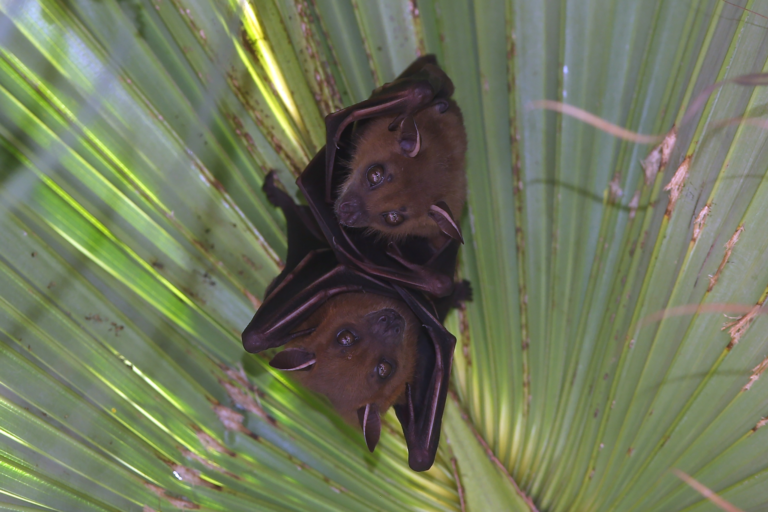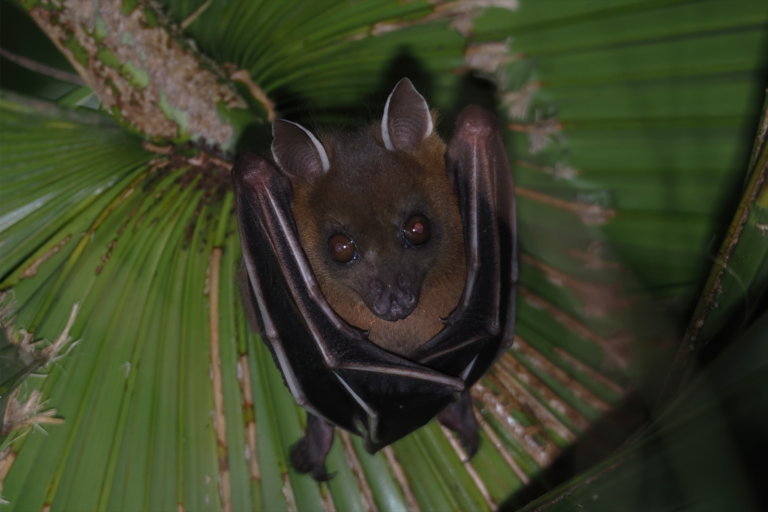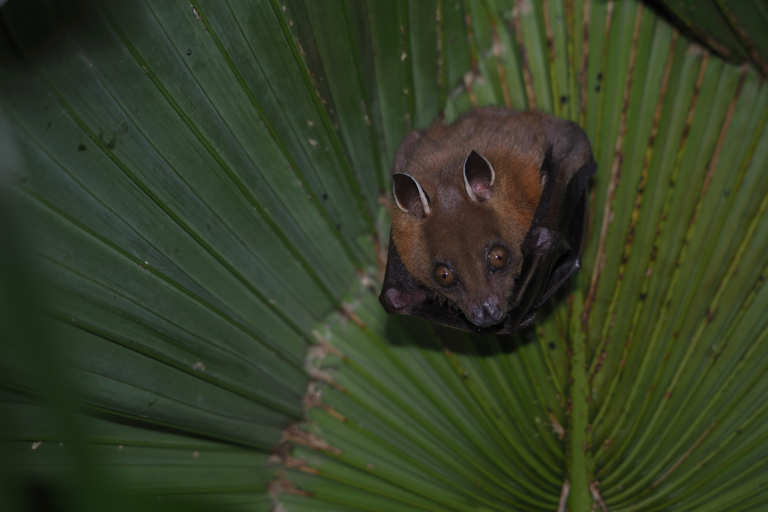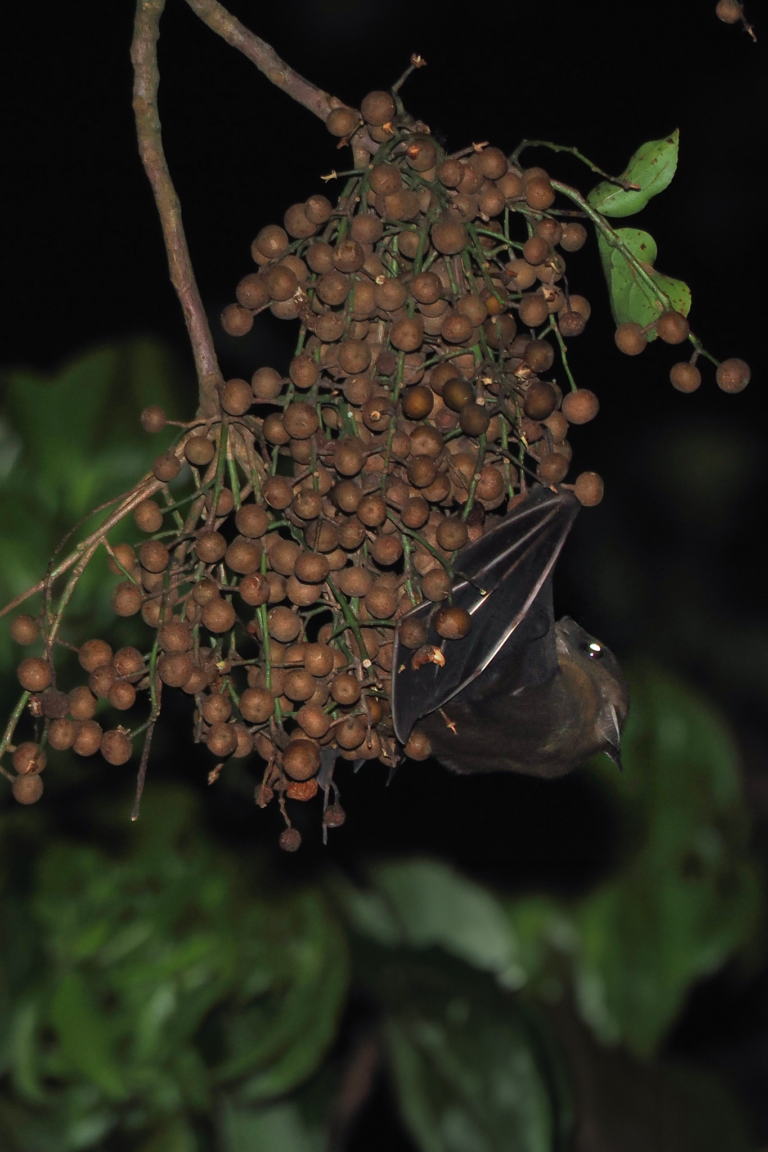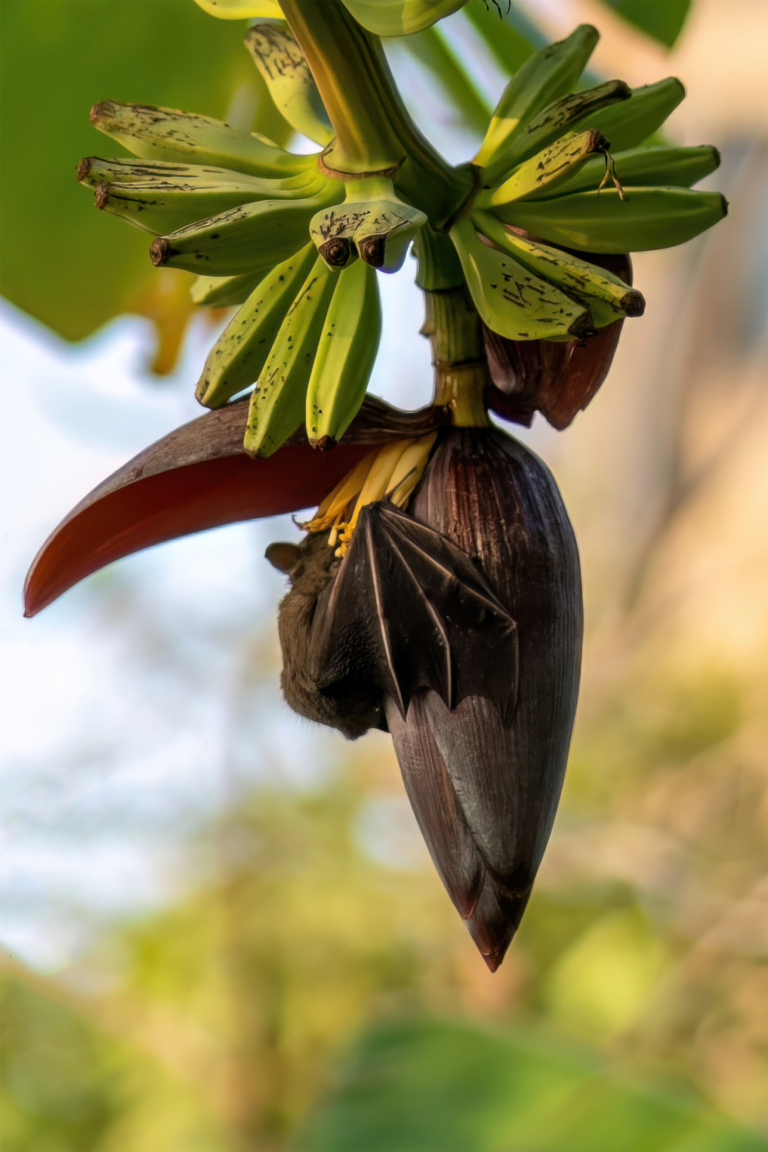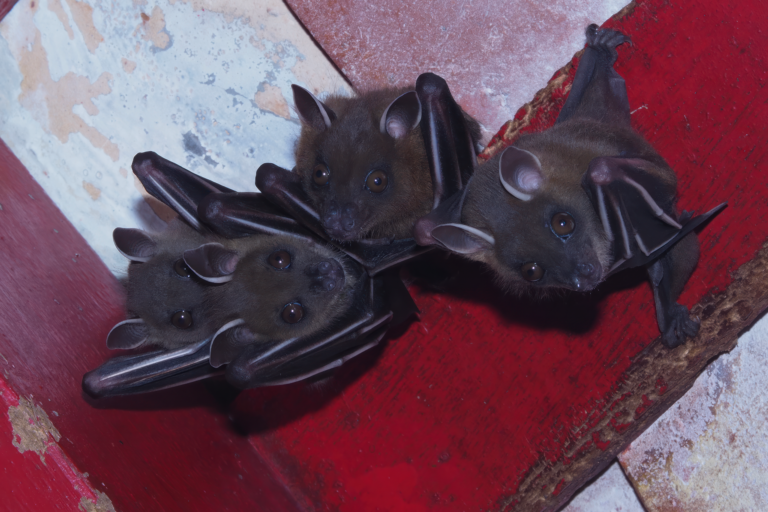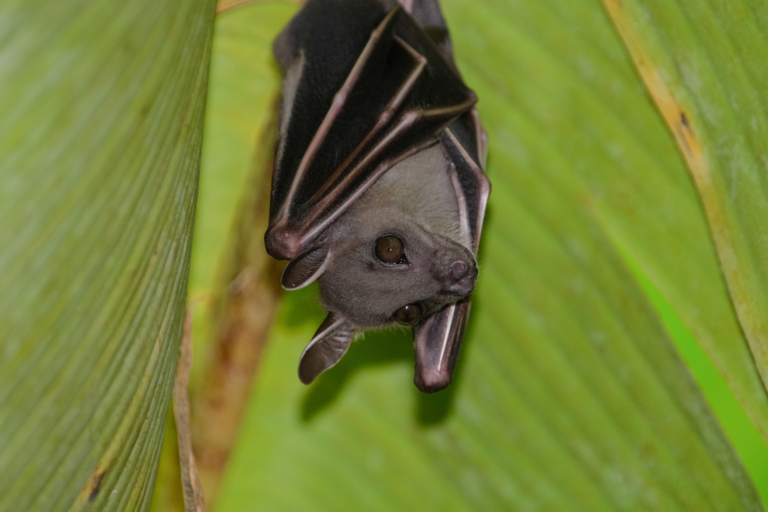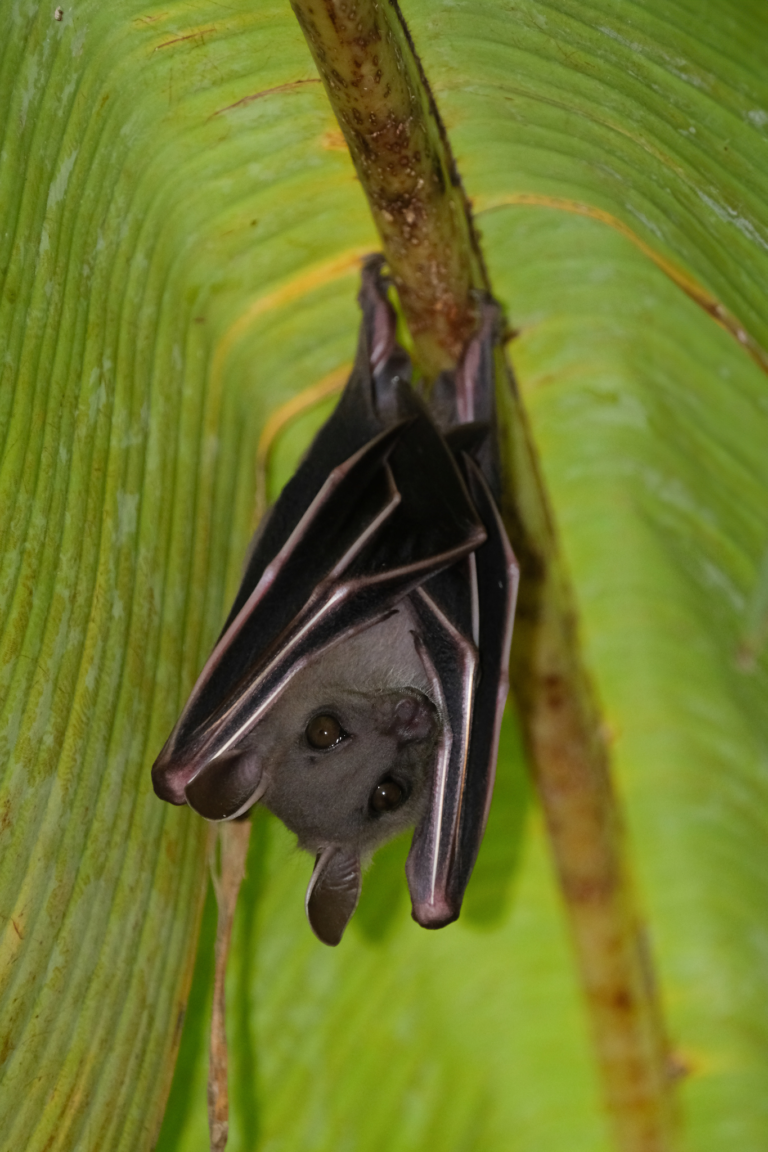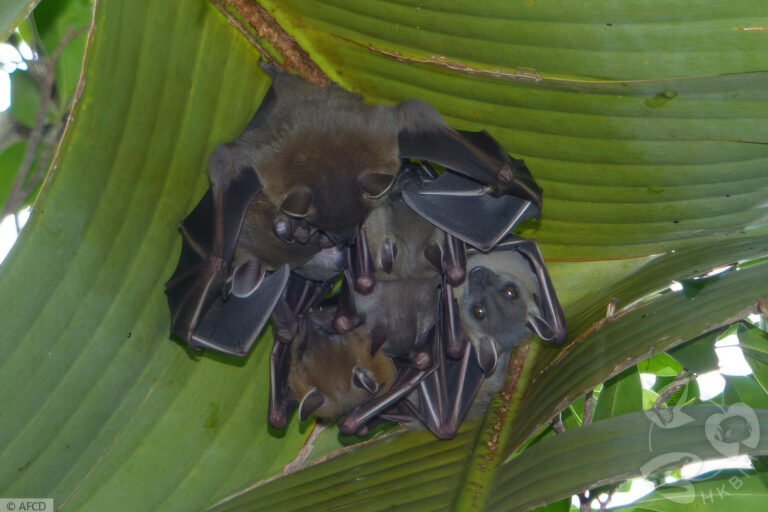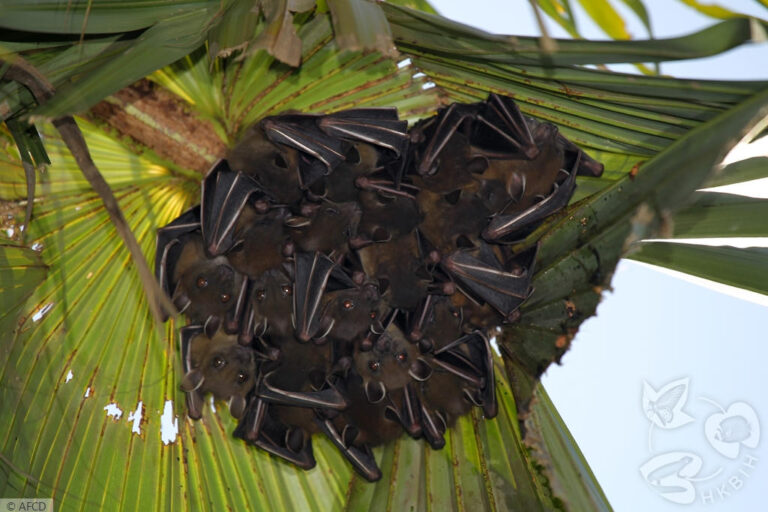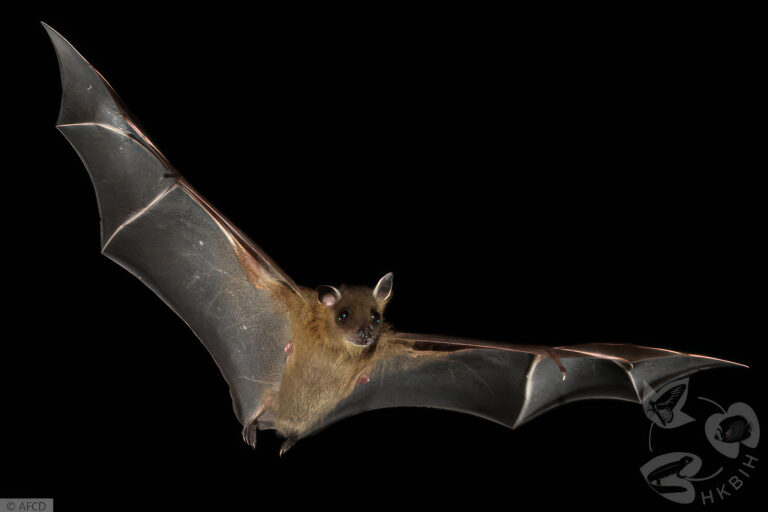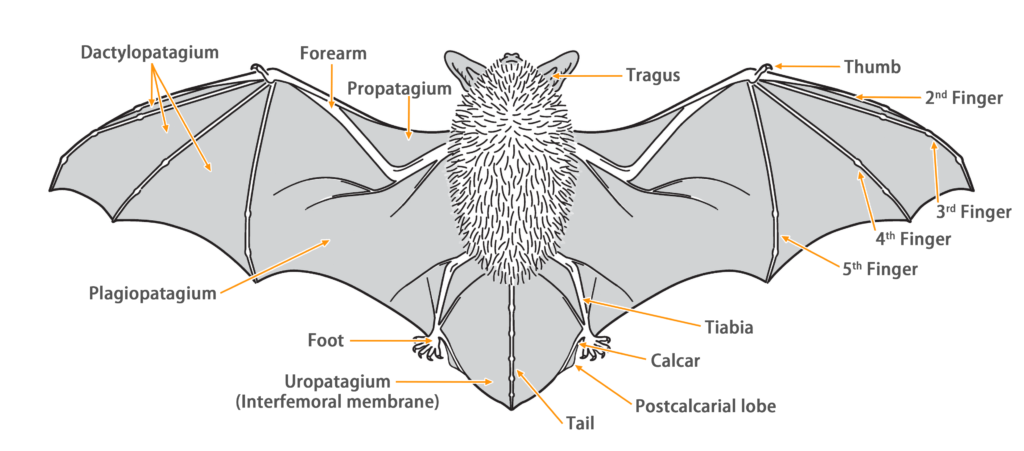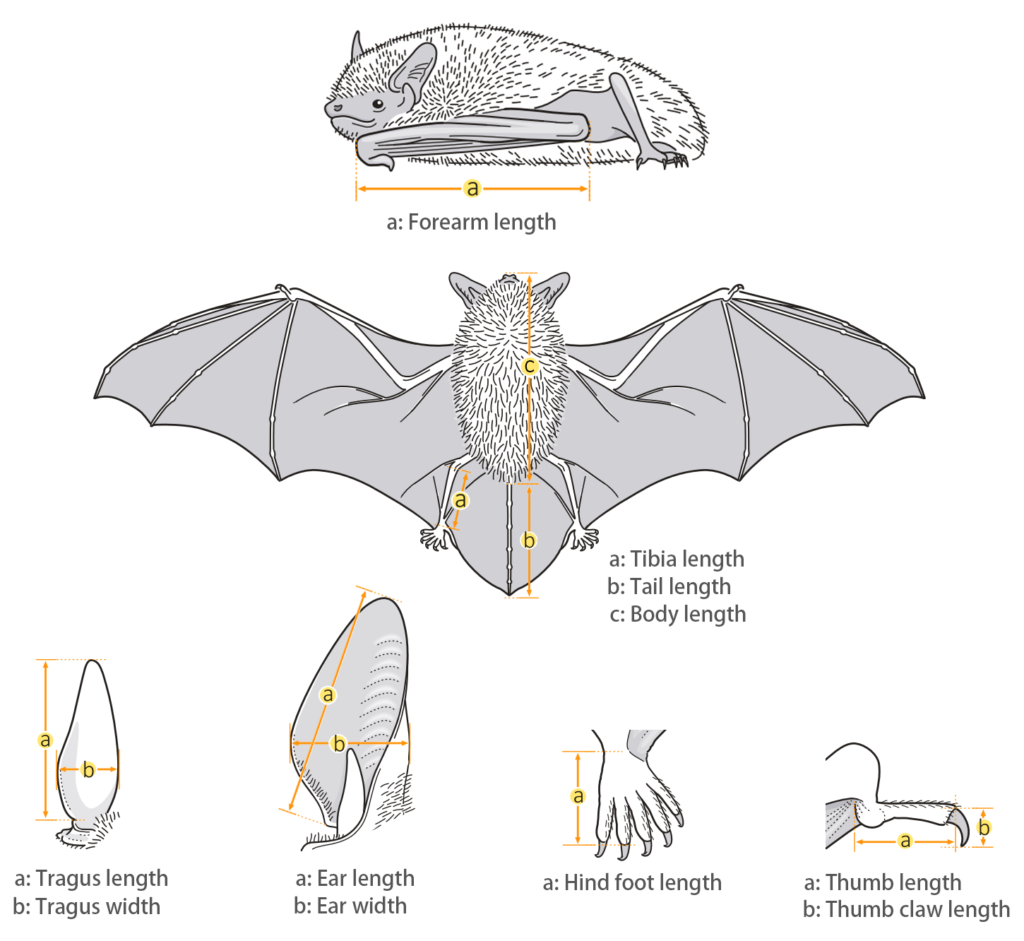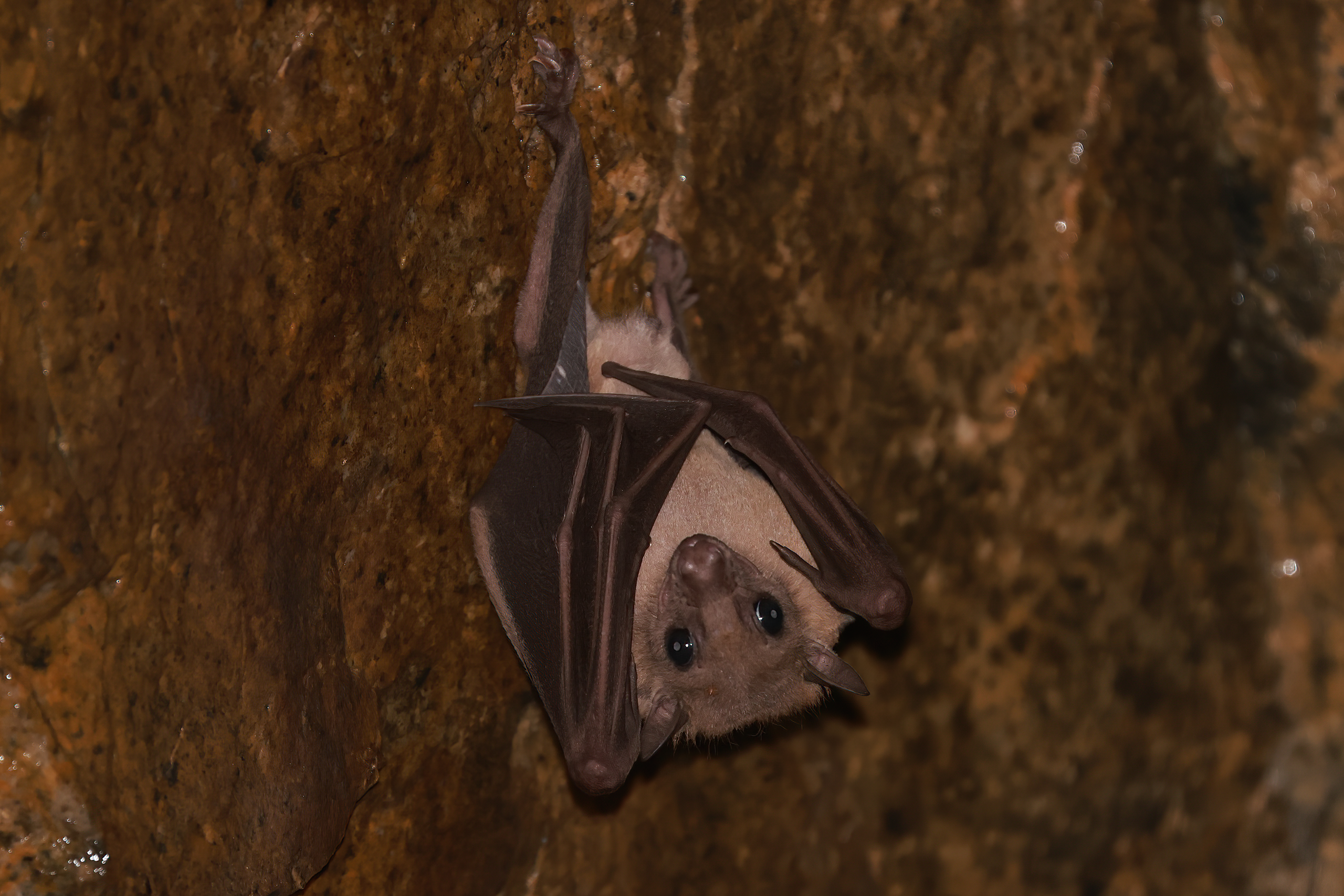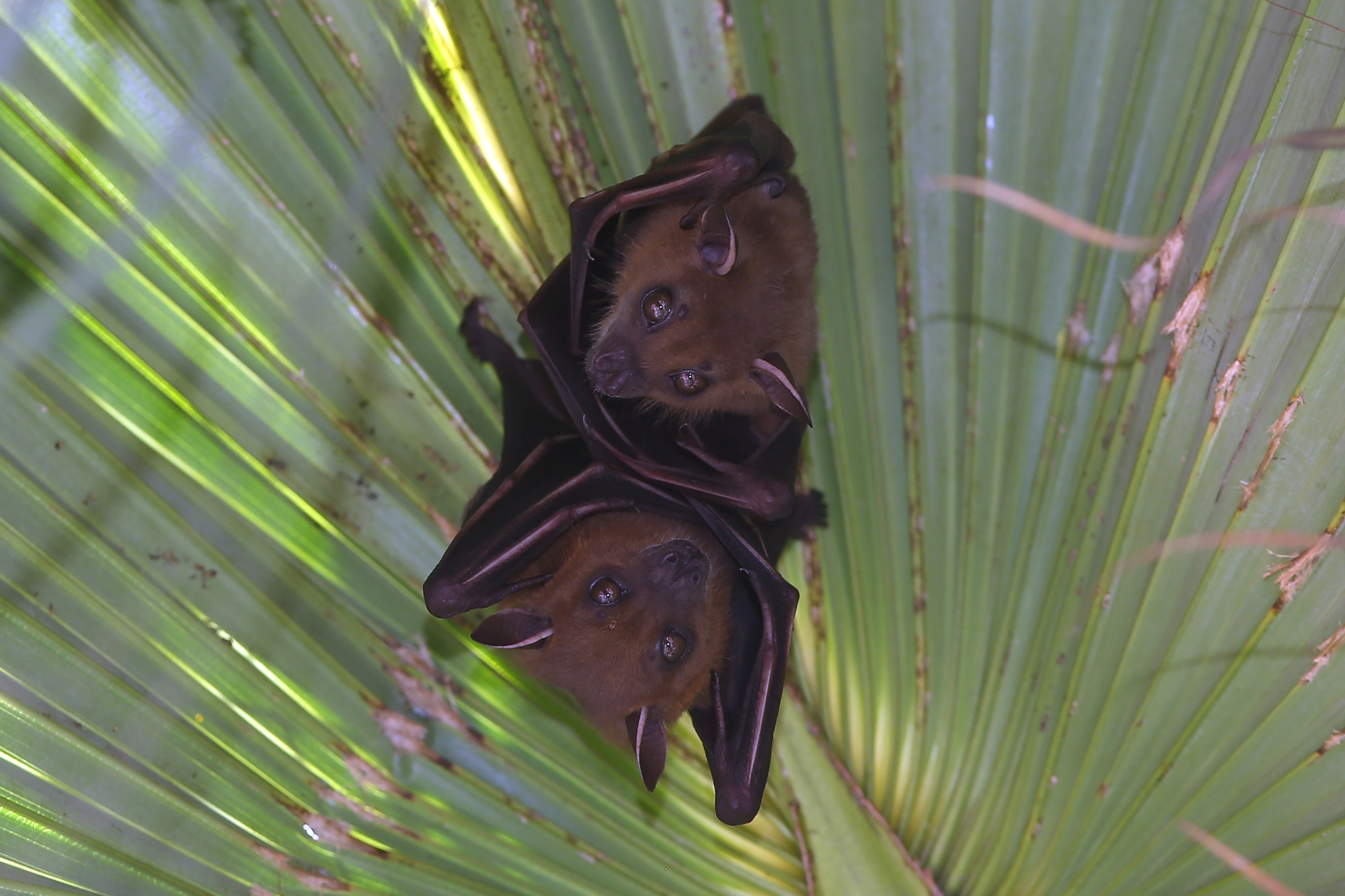- Hong Kong Bat Radar
- Short-nosed Fruit Bat (Cynopterus sphinx)
Short-nosed Fruit Bat
Cynopterus sphinx (Vahl, 1797)
Taxonomy
| Family: | Pteropodidae |
| Genus: | Cynopterus |
| Scientific name: | Cynopterus sphinx (Vahl, 1797) |
| Synonyms: |
Cynopterus angulatus Miller, 1898 Pachysoma brevicaudatum Temminck, 1837 Pteropus pusillus É. Geoffroy, 1803 Vespertilio sphinx Vahl, 1797 |
| Common name: | Short-nosed Fruit Bat |
| Other name: | Greater Short-nosed Fruit Bat, Short-nosed Indian Fruit Bat, Dog-faced Fruit Bat, Sphinx Fruit Bat |
| Remark: | This species comprises six known subspecies: C. s. sphinx (Vahl, 1797), C. s. angulatus (G.S.Miller, 1898), C. s. babi (Lyon,1916), C. s. pagensis (G.S.Miller, 1906), C. s. scherzeri (Zelebor,1869) and C. s. serasani (Paradiso, 1971). Based on geographic distribution, the short-nosed fruit bat in Hong Kong belongs to the subspecies C. s. angulatus. |
| Characteristics | |
| Color: | The dorsal fur exhibits shades of gray-brown to dark brown, while the ventral fur is relatively lighter in color. In males, there is a distinct and stiff fur around the neck, appearing in a deeper shade of orange, while in females, the neck mane is more of a yellow-brown color. Juveniles have an overall light gray fur color, lacking the orange or yellow tones. |
| Ear: | The ear pinna is oval-shaped and dark brown, with a smooth white outer edge and a pointed tip. There are no tragus or antitragus present. |
| Head: | The facial features resemble those of a dog, with large and prominent eyes, yellow-brown irises, and a relatively short snout. |
| Limbs: | The phalanges on the wing membrane are lighter in color, exhibiting a dark pinkish hue. The wing membrane connects to the middle part of the toes. |
| Tail: | The tail is extremely short, with a very narrow interfemoral membrane. Half of the tail is free from the interfemoral membrane. |
| Other: | During the breeding season, females have prominent nipples located below each armpit, while males have a noticeably enlarged scrotum during the mating period. Male individuals generally have a larger body size and higher vigilance compared to females. |
| Body measurements | |
| Size: | Medium Fruit bat |
| Body: | 89.0 - 109.0 mm |
| Tail: | 13.0 - 18.0 mm |
| Ears: | 19.0 - 23.0 mm |
| Hind foot: | 14.5 - 20.5 mm |
| Forearm: | 67.0 - 76.0 mm |
| Weight: | 28.0 - 70.0 g |
| Wing morphology | |
| Wing span: | 0.441 m |
| Wing area: | 0.036 m2 |
| Wing loading: | 12.78 ± 0.75 N/m2 (High) |
| Aspect ratio: | 5.50 ± 0.32 (Low) |
| Tip-shape index: | 1.18 ± 0.04 (Low) |
| Reference: | Furey & Racey, 2016 |
Ecology
| Habitat: | The local population generally inhabits beneath the leaves of Livistona chinensis and Washingtonia robusta, preferring taller and densely foliated palm trees. Some individuals also utilize leaves of banana trees (Musa x paradisiaca) and traveler's palms (Ravenala madagascariensis) for nesting. They may even inhabit buildings such as outer walls, ceilings, beams, light fixtures and ceiling fans. Other plants that can be utilized as roosting sites including: |
| Plant species/genus | Position |
|---|---|
| Borassus flabellifer | Under frond |
| Caryota urens | Fruit clusters |
| Coccothrinax argentea | Under frond |
| Cocos nucifera | Under frond |
| Corypha umbraculifera | Under frond |
| Dracaena draco | Under leaves |
| Ficus elastica |
Behind bark/ Aerial root clusters |
| Ficus religiosa | |
| Persea gratissima | Under leaves |
| Philodendron giganteum | Under leaves |
| Polyalthea longifolia | Foliage clusters |
| Roystonia regia | Under frond |
| Sabal palmetto | Under frond |
| Saraca asoka | Foliage clusters |
| Syagrus romanzoffiana | Under frond |
| Trachycarpus fortunei | Under frond |
| Roystonea regia | Fruit clusters |
| Vernonia scandens | Foliage clusters |
| Habit: | Short-nosed fruit bat is a gregarious species, typically forming colonies consisting of one adult male and multiple females (including juveniles during the breeding season), although solitary males are also observed. The largest recorded colony in the local area comprised 29 individuals. |
| Reproduction: |
The mating season occurs in spring (March to April) and autumn (October to November). It was traditionally believed to be a polygynous species, with one male mating with multiple females. However, recent studies indicate that the short-nosed fruit bat is actually a polygynandrous species, with multiple males and females engaging in multiple mating. Adult males construct tent-like nests using leaves of Livistona chinensis or Washingtonia robusta before autumn. These nests attract females, forming a polygynandrous social structure for mating and reproduction. The female members of the social group are not fixed, as they can freely move between different "harems" during the night to mate. They may also visit the tent-like nests of solitary males to mate. They has two distinct reproductive periods: one in spring (March to April) and the other in summer to autumn (June to October). The actual timing of reproduction can vary among individuals due to factors such as temperature and food availability. Adult female bats become pregnant after mating in autumn and undergo a delayed embryo development period. The gestation period lasts approximately 150 days, and they give birth to their first litter during the transition from winter to spring. Following the birth of their first litter, the females enter a postpartum estrus phase and can mate again while nursing their offspring. The subsequent pregnancy period is around 120 days without delayed embryo development. The second litter is born during the summer to autumn season, with the latest births occurring around late October. |
| Hibernation: | Short-nosed fruit bat is active throughout the year and does not hibernate. |
| Flight: | Although they have lower flight efficiency, maneuverability, and hovering capabilities, they possess a high wing loading, excellent flight capacity, and speed, making them well-suited for mid-range flights. They typically navigate along forest paths or near the canopy layer, preferentially flying below the canopy (<3.5 meters) |
| Foraging: | Typically, they only leave the roost to forage and engage in activities half an hour after sunset. There are two peaks of foraging activity during the night and early morning (21:00-22:00 and 02:00-03:00). They usually fly to fruit trees in their foraging areas to pluck fruits, and then return to their day roost or fly to nearby night roosts (such as branches, empty tent nests, or buildings) to consume the fruits. They continuously shuttle between fruit trees and day/night roosts each night. Small-sized fruits (such as figs) and floral nectar (such as Bombax ceiba) are typically consumed on the spot. Medium-sized fruits (such as malabar plum, longans, and lychees) are taken back to the day/night roosts, where the bats squeeze out the juice in their mouths and then spit out the seeds and fibers. If the fruit is too large to carry (such as mangoes and guavas), they may bite and consume it directly on the fruit tree. |
| Diet: | Short-nosed fruit bat is a herbivorous species that feeds on a variety of plant materials, including fruits (such as figs and guavas), floral nectar (such as Bombax ceiba and Syzygium jambos), leaves (such as Cleistocalyx operculatus and Ficus altissima), and stems (such as sugarcane). They consume fully developed fruits, including both ripe and unripe ones. Fruits provide abundant carbohydrates such as fructose, while leaves offer essential minerals such as calcium, potassium, and phosphorus. The short-nosed fruit bat has a wide range of plant species in its diet, as documented in numerous studies. The tables below provide a summary of dietary surveys conducted in Hong Kong and neighboring regions. |
| Plant species/genus | Food |
|---|---|
| Bischofia polycarpa | Fruit |
| Bombax ceiba | Nectar |
| Ceiba pentandra | Nectar |
| Citrus reticulata | Fruit |
| Clausena lansium | Fruit |
| Dimocarous longan | Fruit |
| Eriobotrya japonica | Fruit |
| Ficus altissima | Fruit |
| F. drupacea | Fruit |
| F. fistulosa | Fruit |
| F. hispida | Fruit |
| F. microcarpa | Fruit |
| F. nervosa | Fruit |
| F. pumila | Fruit |
| F. religiosa | Fruit |
| F. rumphii | Fruit |
| F. subpisocarpa | Fruit |
| F. variegata | Fruit |
| F. virens | Fruit |
| Litchi chinensis | Fruit |
| Melia azedarach | Fruit |
| Musa x paradisiaca | Nectar |
| Psidium guajava | Fruit |
| Roystonea regia | Fruit |
| Syagrus romanzoffiana | Fruit |
| Syzygium jambos |
Fruit/ Nectar |
| Terminalia catappa | Fruit |
Diet composition of C. sphinx in Hong Kong (Corlett, 2005, 2006; Seeburrun, 2019; Self observation)
| Plant species/genus | Food |
|---|---|
| Averrhoa carambola | Fruit |
| Carica papaya | Fruit |
| Clausena lansium | Fruit |
| Dalbergia balansae | Leaf |
| Cleistocalyx operculatus | Leaf |
| Dimocarous longan | Fruit |
| Elaeis guineensis | Fruit |
| Ficus sp. | Fruit |
| F. altissima | Fruit |
| F. hispida | Fruit |
| F. virens | Fruit |
| Litchi chinensis | Fruit |
| Livistona subglobosa | Fruit |
| Mangifera indica | Fruit |
| Manilkara zapota | Fruit |
| Melia azedarach | Fruit |
| Musa sapientum | Fruit |
| Prunus persica | Fruit |
| Psidium guajava | Fruit |
| Syzygium cumini | Fruit |
| S. jambos | Fruit |
| S. samarangense | Fruit |
Diet composition of C. sphinx in
Guangzhou, China (Wu et al., 2008)
| Plant species/genus | Food |
|---|---|
| Anthocephalus chinensis | Fruit |
| Averrhoa carambola | Fruit |
| Beilschmiedia purpurascens | Leaf |
| Diospyros nigrocart | Fruit |
| Dimocarous longan | Fruit |
| Ficus callosa | Fruit |
| F. fannulata | Fruit |
| F. fistulosa | Fruit |
| F. hispida | Fruit |
| F. racemosa | Fruit |
| F. tinctoria | Fruit |
| Litchi chinensis | Fruit |
| Mangifera indica | Fruit |
| Manilkara zapota | Fruit |
| Musa acuminate | Fruit |
| Morus macroura | Fruit |
| Nephelium lappaceum | Fruit |
| Pellacalyx yunnanensis | Fruit |
| Psidium guajava | Fruit |
| Pygeum latifolium | Fruit |
| Sapindus rarak | Leaf |
| Sapium baccatum | Fruit |
Diet composition of C. sphinx in Xishuangbanna, China (Tang et al., 2005)
| Plant species/genus | Food |
|---|---|
| Annona squamosa | Fruit |
| Carcinia oblongifolia | Fruit |
| Carica papaya | Fruit |
| Melia azedarach | Fruit |
| Ficus altissima | Leaf |
| F. auriculate | Fruit |
| F. benjamina | Fruit |
| F. hispida | Fruit |
| Psidium guajava | Fruit |
| Rubus hainanensis | Fruit |
| Saccharum officinarum | Stem |
| Solanum procumbens | Fruit |
| Terminalia catappa | Fruit |
| Toddalia asiatica | Leaf |
Diet composition of C. sphinx in winter in Haikou, China (Zhu et al., 2007)
Distribution
| Local: | New Territory, Hong Kong Island and Lantau Island |
| Global: | |
| C. s. sphinx : | Indian subcontinent, Sout of the Himalayan foot hills from Indus River Valley in Pakistan East to Myanmar border, including Nepal, Bhutan, all India (excluding Thar Desert), Bangladesh, SriLanka, and the Andaman and NicobarIs (except Car NicobarI). |
| C. s. angulatus : | South East Asia from West Myanmar East through South China, including Hainan Isalnd , and South to North Peninsular Malaysia, also in Sumatra, South Borneo, West Java, Bali, West Sumbawa, and South Sulawesi; probably also on LombokI. Records from SangeangI need confirmation. |
| C. s. babi : | Babi Island, off the North West coast of Sumatra. |
| C. s. pagensis : | BatuIs (Tanahmasa and TanahbalaIs) and MentawaiIs( Siberut, Sipora, North Pagai, and South PagaiIs). |
| C. s. scherzeri : | Car NicobarI. |
| C. s. serasani : | Natuna islands (Natuna Besar and Serasan). (Giannini et al., 2019) |
Local distribution map

Global distribution map
(Giannini et al., 2019)
Status and Conservation
| First record: | 1955 |
| Origin: | Native |
| Local status: | Very Common (Shek & Chan, 2006) |
| National status: | Near Threatened (Red List of China Vertebrates) |
| Global status: | Least Concern (IUCN Red List) |
| Potential threat: | TBC |
Similar Species
Leschenault's Rousette
Rousettus leschenaultii
Size:
Relatively larger.
Fur:
Lighter in color, appearing as grayish-brown.
Muzzle:
Relatively elongated.
Ears:
No white borders on the edge.
Limbs:
The phalanges on the wing membrane are darker in color.
Habitat:
Typically inhabits caves, such as water channels, mine tunnels, and sea caves.
Vocalization:
Emits audible "click-click" sounds using its tongue.
Short-nosed Fruit Bat
Cynopterus sphinx
Size:
Relatively smaller.
Fur:
Darker in color, appearing as deep brown, with a yellow-brown collar around the neck.
Muzzle:
Relatively shorter.
Ears:
Noticeable white borders on the edge.
Limbs:
The phalanges on the wing membrane are lighter in color, exhibiting a dark pink hue.
Habitat:
Typically nests and resides beneath the leaves of Hibiscus or Bauhinia plants.
Vocalization:
Don't use tongue clicks for echolocation.
Bibliography
Balasingh, J., Koilraj, J., & Kunz, T. H. (1995). Tent construction by the short-nosed fruit bat Cynopterus sphinx (Chiroptera: Pteropodidae) in southern India. Ethology, 100(3), 210-229.
Bhat, H. R. (1994). Observations on the food and feeding behaviour of Cynopterus sphinx Vahl (Chiroptera, Pteropodidae) at Pune, India. Mammalia, 58(3), 363-370.
Chan, C. S. M., & Shek, C. T. (2006). Survey on the short-nosed fruit bat (Cynopterus sphinx) in the urban areas of Hong Kong. Hong Kong Biodiversity, 11, 8-10.
Chan, N. K. W., Lo, A. W. K., & Tsui, W. W. C. (2023). An Overview on Short-nosed Fruit Bat (Cynopterus sphinx) and Its Roost Selection in Urban Parks of Hong Kong. Hong Kong Biodiversity, 27, 20-26.
Corlett, R. T. (2005). Interactions between birds, fruit bats and exotic plants in urban Hong Kong, South China. Urban Ecosystems, 8, 275–283.
Corlett, R. T. (2006). Figs (Ficus, Moraceae) in Urban Hong Kong, South China 1. Biotropica: The Journal of Biology and Conservation, 38(1), 116-121.
Furey, N. M., & Racey, P. A. (2016). Can wing morphology inform conservation priorities for Southeast Asian cave bats?. Biotropica, 48(4), 545-556.
Giannini, N., Burgin, C., Cakenberghe, V. V., Tsang, S., Hintsche, S., Lavery, T., Bonaccorso, F., Almeida, F., & O’Toole, B. (2019). Pteropodidae. In Mittermeier, R. A., & Wilson, D. E. (Eds.), Handbook of the Mammals of the World – Volume 9 Bats. (pp. 16-162). Lynx Edicions.
Jiang, Z. G., Jiang, J. P., Wang, Y. Z., Zhang, E., Zhang, Y. Y., Li, L. L., Xie, F., Cai, B., Cao, L., Zheng, G. M., Dong, L., Zhang, Z. W., Ding, P., Luo, Z. H., Ding, C. Q., Ma, Z. J., Tang, S. H., Cao, W. X., Li, C. W., Hu, H. J., Ma, Y., Wu, Y., Wang, Y. X., Zhou, K. Y., Liu, S. Y., Chen, Y. Y., Li, J. T., Feng, Z. J., Wang, Y., Wang, B., Li, C., Song, X. L., Cai, L., Zang, C. X., Zeng, Y., Meng, Z. B., Fang, H. X., & Ping, X. G. (2016). Red List of China’s Vertebrates. Biodiversity Science 24(5), 500‑551.
Karuppudurai, T., & Ramesh, S. C. (2021). Dispersal Patterns, Mating Strategy and Genetic Diversity in the Short Nosed Fruit Bat Cynopterus sphinx (Chiroptera: Pteropodidae) in Southern India. Bats-Disease-Prone but Beneficial, 101.
Meenakumari, K. J., & Krishna, A. (2005). Delayed embryonic development in the Indian short-nosed fruit bat, Cynopterus sphinx. Zoology, 108(2), 131-140.
Ruby, J., Nathan, P. T., Balasingh, J., & Kunz, T. H. (2000). Chemical composition of fruits and leaves eaten by short-nosed fruit bat, Cynopterus sphinx. Journal of Chemical Ecology, 26(12), 2825-2841.
Seeburrun, G. (2019). Habitat Suitability of Hong Kong’s Urban Parks for Short-nosed Fruit Bats Cynopterus Sphinx. [Master’s thesis, University of Hong Kong].
Shek, C. T. (2006). A Field Guide to the Terrestrial Mammals of Hong Kong. Friends of country park and cosmos book limited.
Shek, C. T., & Chan, C.S.M. (2006). Mist Net Survey of Bats with Three New Bat Species Records for Hong Kong. Hong Kong Biodiversity, 11: 1-7.
Srinivasulu, B., & Srinivasulu, C. (2001). Magnitude of depredation on grapes by short-nosed fruit bats Cynopterus sphinx in Secunderabad, India. Current Science, 80(1), 14-15.
Sudhakaran, M. R., & Doss, P. S. (2012). Food and foraging preferences of three pteropodid bats in southern India. Journal of Threatened Taxa, 4(1), 2295-2303.
Tang, Z. H., Sheng, L. X., Cao, M., Liang, B., & Zhang, S. Y. (2005). Diet of Cynopterus sphinx and Rousettus leschenaulti in Xishuangbanna. Acta Theriologica Sinica, 25(4), 367-372.
Thong, V. D., Denzinger, A., Sang, N. V., Huyen, N. T. T., Thanh, H. T., Loi, D. N., Nha, P. V., Viet, N. V., Tien, P. D., Tuanmu, M.-N., Huang, J. C.-C., Thongphachanh, L., Luong, N. T., & Schnitzler, H. U. (2021). Bat Diversity in Cat Ba Biosphere Reserve, Northeastern Vietnam, A Review with New Records from Mangrove Ecosystem. Diversity, 13(8), 376.
Wu, Y., Zhang, C. J., Wu, Q. Z., & Yang, R. Y. (2008). Feeding Habits of Cynopterus sphinx in Guangzhou Area. Zoological Research, 29(1), 103-107.
Zhu, G. J. (2007). Diet, roost type of greater short-nosed Fruit Bat (Cynopterus sphinx) and activity of Fulvous fruit bat (Rousettus leschenaultia) in Winter in Hainan Island. [Master’s thesis, Hainan Normal University].
Zhu, G. J., Tang, Z. H., Liang, B., & Zhang, X. W. (2007). Diet and Roost Site of Cynopterus sphinx in Winter in Haikou. Chinese Journal of Zoology, 42(4), 22-27.
Hong Kong Bat Radar. (01/05/2024). A Field Guide to Bats of Hong Kong: Short-nosed Fruit Bat (Cynopterus sphinx ). https://hkbatradar.com/en/cynopterus_sphinx
